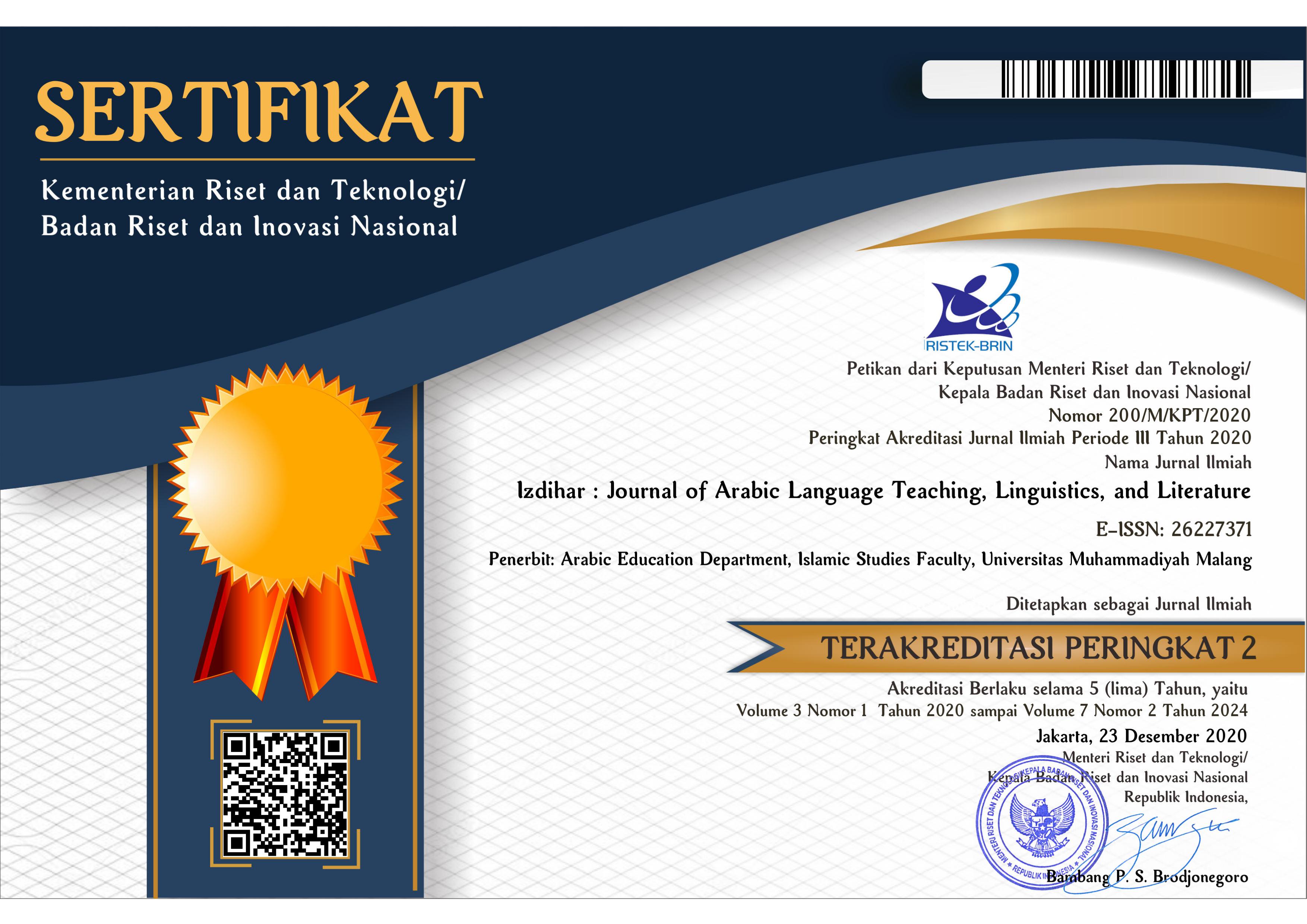Kitābah Online Learning Strategy With The Scamper Method
DOI:
https://doi.org/10.22219/jiz.v5i1.18999Keywords:
Arabic writing Lesson; Scamper Method; Online BasedAbstract
This research aimed to examine projects in creative Arabic writing by online learning with the scamper method. The object of research in this study was UIN Sunan Kalijaga's 4th semester of Arabic language and literature students. The research design used was True - Experimental Designs. Data collection techniques were observation, interviews, questionnaires, tests, and documentation. Research showed that the process of learning creative Arabic writing using online-based Scamper methods in kitābah courses is declared effective, with the results of the pretest test -t independent simple test showed that sig. 0.003 < 0.05. While the results of the posttest test-t independent simple test showed sig. 0.00 < 0.05. Strengthened by the analysis of the test-paired sample test showed a level sig. 0.00 < 0.05 so that it was concluded under Ha accepted and there was a significant difference. As for the results of learning to write creative Arabic with the scamper method after treatment in the experimental group, this can be seen from the increase in the experimental group by 18% and the control group only by 9,2% . This proved that there were significant differences before and after using learning strategies with scamper methods based on online experiment classes in writing creative Arabic on kitābah courses.
Downloads
References
Arifin, Zainul. (2009). Muqoddamah fiqih strategi pembelajaran dan pengajaran bahasa Arab. Hayfa Press.
Arikunto, S. (2002). Metodologi penelitian suatu pendekatan proposal. PT. Rineka Cipta,.
Azzuhri, M. (2009). Metode dan media pembelajaran bahasa Arab berbasis internet di era teknologi informasi. INSANIA: Jurnal Pemikiran Alternatif Kependidikan, 14(3), 348-445. DOI:10.24090/insania.v14i3.360
Cahyati, H., Muin, A., & Musyrifah, E. (2018). Efektivitas Teknik SCAMPER dalam Mengembangkan Kemampuan Berpikir Kreatif Matematis Siswa. Journal of Medives: Journal of Mathematics Education IKIP Veteran Semarang, 2(2), 173-182. DOI:10.31331/medives.v2i2.641
Dimyathi, M. A. (2016). Panduan praktis menulis bahasa Arab.
Effendi, ahmad fuad. (2017). t.t. metode pendidikan bahasa arab. Misykat.
Fajar, Qoyyumul. (2021). Mahasiswa Bahasa Dan Sastra Arab UIN Sunan Kalijaga.
Hamid, M. A. (2013). Mengukur kemampuan bahasa arab: Untuk studi islam.
Hawa, S., & Yosef, Y. (2019). Aplikasi metode scamper dalam pengembangan desain pembelajaran matematika di sekolah dasar. Jurnal Pendidikan Matematika, 13(2), 143-152. DOI: https://doi.org/10.22342/jpm.13.2.6749.143-152
Hermawan, Acep. (2011). metodologi pembelajaran bahasa Arab. Rosdakarya.
Islim, O. F., & Karatas, S. (2016). Using the scamper technique in an ict course to enhance creative problem solving skills: An experimental study. Turkish Online Journal of Educational Technology, 2016(DecemberSpecialIssue), 1291–1296. https://hdl.handle.net/20.500.12513/1734
Istamova, D. S. (2021). Ways of using scamper technology during foreign language lessons. Current Research Journal of Pedagogics, 02(12), 149–155. DOI: https://doi.org/10.37547/pedagogics-crjp-02-12-30
Maftukhah, Nur Ajeng, Khomsun Nurhalim & Isnarto. (2017). Kemampuan berfikir kreatif dalam pembelajaran model connecting organizing reflecting extending ditinjau dari kecerdasan emosional. Jurnal Of Primary Education. DOI: 10.15294/JPE.V6I3.21141
Muradi, Ahmad. (2013). Tujuan pembelajaran bahasa asing (Arab) di Indonesia.Jurnal Al-Maqoyis, 1(1). DOI: http://dx.doi.org/10.18592/jams.v1i1.182
Musthofa, Bisri, Abdul Hamid. (2012). Strategi belajar bahasa Arab : Teori&praktik. Malang: UIN Maliki Press.
Mustofa, syaiful. (2011). Strategi Pembelajaran Bahasa Arab Inovatif. malang: uin malang.
Ni’mah Suseno, Miftahun. (2012). Statistika: Teori dan aplikasi untuk penelitian ilmu sosial dan humaniora. Ash-Shaff.
Nugroho, R.A.(2018). Higher order thinking skills. Grasindo.
Özyaprak, M. (2016). The effectiveness of SCAMPER technique on creative thinking skills. Journal for the Education of Gifted Young Scientists, 4(1), 31–40. DOI: https://doi.org/10.17478/JEGYS.2016116348
Panjaitan, Agustina Hariani, Edy Surya. (2017). Creative Thingking (Berfikir Kreatif) Dalam Pembelajaran Matematika. ABA Journal, 102(4).
Pawliczak, Joanna. (2015). Creative writing as the best way to improve writing skills of students. Sino-US English Teaching, 12(5). DOI: 10.17265/1539-8072/2015.05.004
Rukminingsih, Adnan, G., & Latief, M. A. (2020). Metode penelitian pendidikan. penelitian kuantitatif, penelitian kualitatif, penelitian tindakan kelas. Journal of Chemical Information and Modeling, 53 (9).
Sari, risna rianti. (2019). Scamper sebagai strategi menulis kreatif bahasa Arab abad 21. jurnal Arabi , 4(2), 182-187. DOI: https://doi.org/10.24865/ajas.v4i2.182
Septiadhi, Dwinanda. (2019). Disrupsi S.I.A.P (Strategi, Inovasi dan, Aplikasinya untuk menjadi, Pemenang). Baraqa Publishing.
Sismi, Elma. (2020). Penerapan metode SCAMPER dalam upaya meningkatkan hasil belajar peserta didik kelas V Pada Tema Ekosistem Di SDN 25 Lawang Kidul. Skripsi, Indralaya: Universitas Sriwijaya.
Sudrajat, Akhmad. (2012). SCAMPER untuk pembelajaran kreatif dan inovatif. Blog tentang Pendidikan (blog). https://akhmadsudrajat.wordpress.com/2012/08/28/scamper-untuk-pembelajaran-kreatif-dan-inovatif/#
Sugiyono, M. P. P., & Kuantitatif, P. (2011). Kualitatif, dan R&D, Alfabeta. Cet. Vii.
Sugiyono, D. (2013). Metode penelitian pendidikan pendekatan kuantitatif, kualitatif dan R&D.
Suhairi, Iskandar. (2021). Mahasiswa Bahasa Dan Sastra Arab UIN Sunan Kalijaga.
Sumardi, Muljanto. (1974). Pengajaran Bahasa Asing Sebuah Tinjauan dari segi Metodologi. Jakarta: Bulan Bintang.
Tahir, Martiani. (2019). Penerapan metode scamper dalam mengembangkan kemampuan pemecahan masalah ditinjau dari motivasis mahasiswa pendidikan matematika Universitas Sembilan Belas November Kolaka. Jurnal Silogisme, 4(2), 43-48. DOI : 10.24269/silogisme.v4i2.2072
Toraman, Sinem, Sertel Altun. (2013). Application of the Six Thinking Hats and SCAMPER Techniques on the 7th Grade Course Unit ‘Human and Environment’: An Exemplary Case Study. Mevlana International Journal of Education (MIJE), 3(4). 166–85. DOI: https://doi.org/10.13054/mije.13.62.3.4
Downloads
Published
How to Cite
Issue
Section
License
Copyright (c) 2022 salimatul Fuadah, Jafar Shodiq, Izdihar : Journal of Arabic Language Teaching, Linguistics, and Literature

This work is licensed under a Creative Commons Attribution-ShareAlike 4.0 International License.
Copyright Notice
Authors who publish with this journal agree to the following terms:
- Authors retain copyright and grant the journal right of first publication with the work simultaneously licensed under a Creative Commons Attribution-ShareAlike 4.0 International License that allows others to share the work with an acknowledgment of the work's authorship and initial publication in this journal.
- Authors are able to enter into separate, additional contractual arrangements for the non-exclusive distribution of the journal's published version of the work (e.g., post it to an institutional repository or publish it in a book), with an acknowledgment of its initial publication in this journal.
- Authors are permitted and encouraged to post their work online (e.g., in institutional repositories or on their website) prior to and during the submission process, as it can lead to productive exchanges, as well as earlier and greater citation of published work (See The Effect of Open Access).
Copyright (c) 2019 Izdihar : Journal of Arabic Language Teaching, Linguistics, and Literature

This work is licensed under a Creative Commons Attribution-ShareAlike 4.0 International License.

















